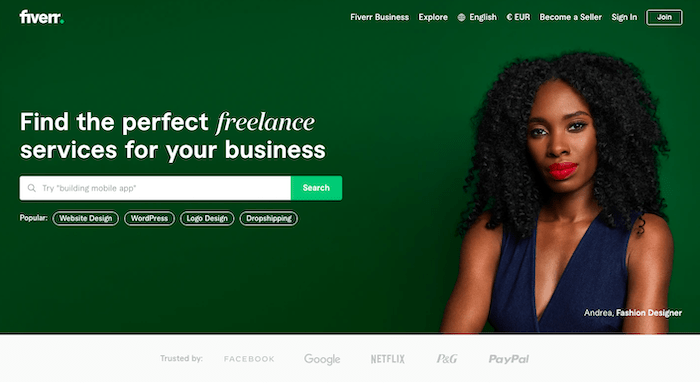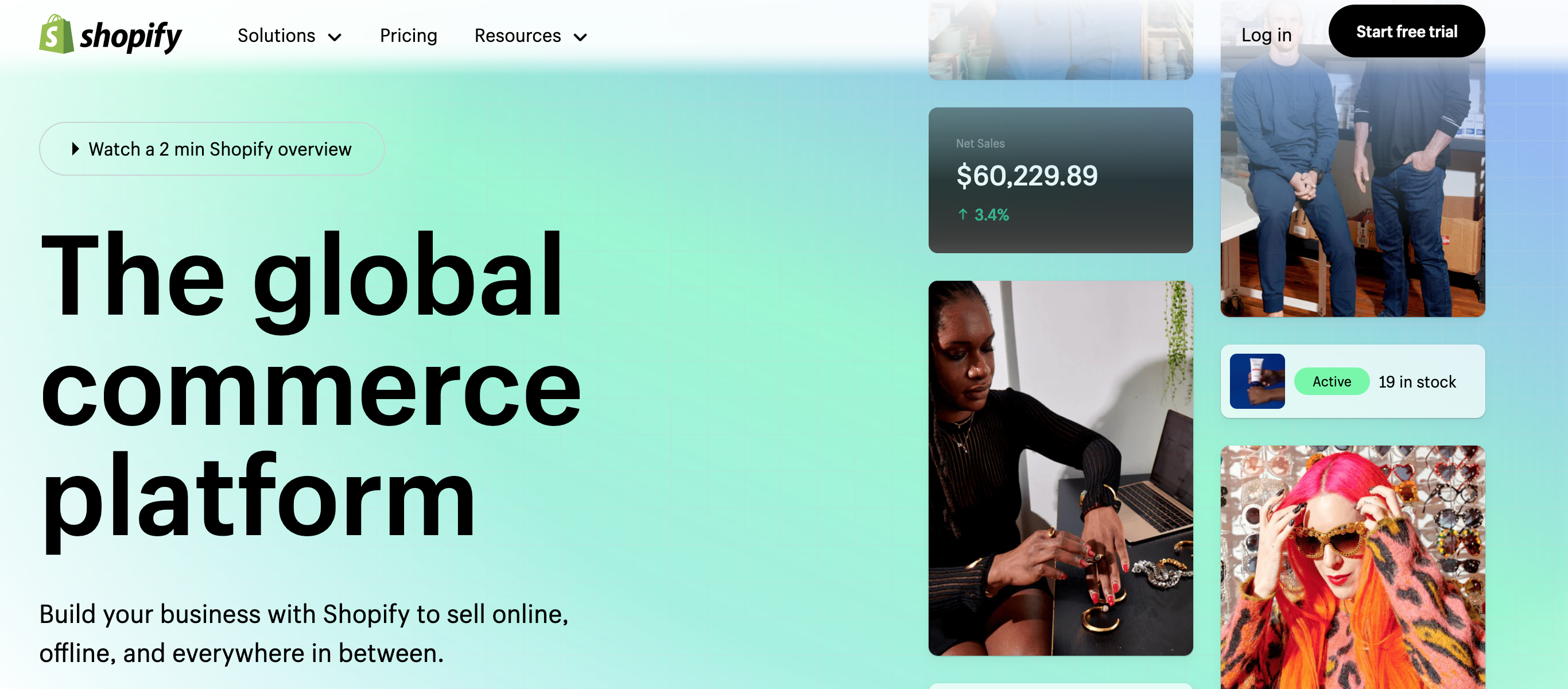Rapid advances in technology have made it easier and cheaper to start a clothing retail business online – either as a side hustle or a full time income stream.
The growth of ecommerce, social commerce and mobile commerce represents a wide spectrum of opportunities for entrepreneurs who want to reach a global audience with their digital clothing business.
How to Sell Your Own Clothing Brand Online: A Shopify Guide

This guide is focused on walking you through the process you need to follow to sell your own clothing brand online.
We will show you how to do this step by step, and why leveraging a solid ecommerce platform like Shopify takes care of about 60% factors for ensuring the success of your online clothing store.
Introduction
As you are reading this, understand why now is the best time to start your online clothing brand. The traditional fashion landscape is experiencing rapid changes. Also, the digital realm has become a booming frontier for clothing brands that want to leverage the digital space to reach a global market.
Now is the time!
Benefits of Selling Your Own Clothing Brand Online
1. Global Reach: The internet allows you to reach people you would not otherwise reach outside the digital world. The internet also enables you to showcase your own clothing brand to a diverse, unlimited global worldwide audience, giving our brand maximum mileage beyond your geographical boundaries.
2. Lower Overheads: With an online clothing brand there are no hefty overheads to worry about. Even in cases where you may choose to maintain a hybrid approach (online plus physical), the overheads are comparatively less than what it takes to run a typical brick and mortar store.
3. 24/7 Accessibility: Your online store is not timezone constrained because it is cyber. Your online boutique will therefore be open round the clock. This allows customers to explore your online store, browse, search and make purchases at their convenience. You will essentially be making money while you are sleeping.
4. Data-Driven Insights: E-commerce platforms such Shopify have robust traffic, inventory and sales analytics that provide valuable data on customer behaviour and overall business performance. This is crucial data you will leverage to map out growth points for your online clothing brand and areas that need improvement.
A 10 Step Guide to Selling Your Own Clothing Brand Online
1. Market Research and Planning
Market research is the first step you need to take into starting your own clothing brand online. This exercise enables you to understand the dynamics of the current market.
Market research will help to map out the gaps that align with your passions and interests to hone in a product offering that meets the needs and preferences of your customers.
Identifying Your Target Audience
In this exercise you need to zero in on who your target and ideal customer really is. Constructing a persona can be helpful. To do this you can make use of questions such as:
- What does your target customer look like?
- Where does he live?
- What is his or her lifestyle?
- How much income does he/she have?
- What are his/her demographics (race, gender, age, etc)?
If you can answer the questions above you are in a better position to answer in relation to how best you can pitch and sell to your target market.
Analysing Competitors
Big part of your market research is competition analysis. As much as you have a passion to do something new, do not disregard the wealth of insight from online clothing brands that have been successful. Study these and try to answer the following questions:
- How did the successful brands start?
- What makes them stand out and successful?
- What are their strengths and weaknesses?
Asking these questions enables you to identify a gap in the market that you can plug. That gap is your niche.
What goes with this exercise is the need to continually assess and monitor global trends to keep pace with current fashions, emerging phenomena and best practices globally and within your niche.
2. Creating a Business Plan
Don’t overlook the need for a business plan. Many entrepreneurs neglect this important principle and just shoot for the sky without a solid plan.
There are several reasons and benefits for creating a business plan:
- It helps put figures and math into your business ideas to assess viability
- It helps you put your ideas into perspective
- It helps you set clear objectives and action plan
- It helps project the financial soundness of your business
- A Business Plan works as a guiding framework
- You can use your business plan to source funding
- You can use your business plan to define your pricing and marketing strategies
- You can use your business plan to assess the performance of your business
A well structured business plan becomes the road map to the success of your online clothing brand.
Critical in the plan will be setting clear business goals and objectives. On this part you will need to define the short term and long term goals of your online clothing boutique.
Budgeting and Financial Planning
This part of your business plan is important for defining how your overall budget looks. Your budget must cover initial investments, operating costs as well as marketing costs.
Your financial projections should give a clear indication of what the overall expected costs look like and what the expected revenue and profit are.
Below is a link to a free Microsoft Word Business Plan Template for starting your own online clothing brand.
[download id=”4898″]
3. Creating a Brand Identity

To get the best branding service from Fiverr you need the following:
A Clear Vision: You need to be clear on what your brand’s identity will be. This should be based on your target audience, brand values as well as the message that you want to convey through your brand.
Budget Planning: You need to determine what your budget is for the branding service. Fiverr has a wide range of pricing options and service providers. Streamlining your budget planning enables you to narrow your choices down.
Make use of Search and Filters: Make use of Fiverr‘s search and filters to find branding experts who are good with handling branding needs for clothing and fashion businesses. Go for providers with high positive ratings and reviews.
Also take time to read portfolios to identify top performing providers. Also make sure you read reviews and then hit up the providers you think are good fit and start engaging them.
Once you have identified the best provider who matches your needs and budget it’s time to contract them to do the work.
Remember that with platforms such as Fiverr your money is safe as fees you pay for the service won’t be released to the service provider if you are not satisfied with their work.
Also don’t forget that the whole branding exercise must be geared towards crafting a compelling brand, messaging and brand personality that resonates with your target market.
4. Designing Clothing Items
Whether you produce your clothing line by yourself or outsource the production to a supplier you need to pay particular attention to design details that speak to your branding. Pay attention to fabric selection, only settle for quality and durable fabrics and solid stitching techniques.
It is also helpful to create prototypes and samples just to ensure the quality of your clothing items before you invest in bulk production.
If you are outsourcing the production of your clothing, stick with tried and tested – reliable suppliers who can meet your volumes, standards and specifications.
5. Setting Up Your Online Store with Shopify
A big part that goes into how successful you own clothing brand online is the quality, security and user friendliness of your online clothing store.
While some prefer to create their stand-alone ecommerce websites, this route comes with a lot of technical aspects in terms of the cost of hiring a developer to build the ecommerce website and to then integrate the ecommerce website with critical third party services such as payment gateways and order fulfilment services, etc.
The other challenge associated with this approach is the hassle and high cost of maintaining such a website.
The Shopify Edge

Robust ecommerce platforms like Shopify enable entrepreneurs to start their own clothing brands online hassle free.
Below are some reasons why Shopify is great choice for a proprietary online clothing brand:
Intuitive and User-Friendly: Shopify offers an intuitive and user-friendly interface for both online store creators and end users (customers). With Shopify you can set up a professional online clothing brand within minutes – and you don’t need any technical (coding and design) skills to do so.
Customizable Templates: Shopify has a pool of highly customizable templates. From these you can create a unique, visually appealing storefront design that matches your branding and niche.
Payment Gateway Integration: On Shopify you don’t have to stress about integrating payment gateways to your shop. Shopify has over 100 payment gateway options (credit/debit cards and digital wallets).
This empowers you to set diverse payment options for the different needs of the global customer base.
Registering a Domain Name
Leveraging solid ecommerce platforms does not mean you need to compromise your branding. When you set up your online store on Shopify for example, you can connect this store with your own domain name.
Your online store will sit on (hosted by) Shopify but it will be connected with your domain wherever that domain is registered and hosted.
Remember that your domain name is an important part of your branding. Settle for a domain name that is short, memorable and brandable. A name that reflects your brand’s personality and is also easy for customers to remember.
I recommend that you register your domain name and host it with Bluehost. With Bluehost you can register and host a custom domain for as little as $9.95 per month
Customizing Your Shopify Website
Now that your domain and online clothing store are connected within Shopify, it is time to build a custom ecommerce website with colors and layout that resonate with your brand.
Shopify has a user-friendly drag and drop interface that you can use to build a high end online store from a wide range of highly customisable themes.
6. Adding Product Listings and Descriptions
With your store set up, you now need to add product listings to your online store. Add detailed product descriptions that highlight the unique offerings and features of your clothing items.
Also make use of high resolution product images and insert compelling calls to action to your listings to drive sales.
Implementing SEO Techniques with Shopify

7. Set Up An Omni-channel Marketing Strategy
You now need to set up an omni-channel marketing strategy for your clothing brand online.

Utilizing Social Media for Marketing: Promote your brand on social media with fresh content from your latest collections.
Make the most of Shopify’s social media integrations to share shoppable products across different social media platforms.
Keep tabs with fashions trends and market sentiment by monitoring social media interactions and trends.
Email Marketing Campaigns: Shopify has integrated email marketing tools that you can make use of to create a newsletter and build a captive audience around your online clothing brand.
With a newsletter, you can keep your customers posted on new arrivals, exclusive offers and promotions. Email marketing is central for building and nurturing customer relationships.
Paid Advertising Options (e.g., Facebook Ads, Google Ads): If your budget allows you can also go for Paid advertising campaigns and aim for quick wins in traffic by running Google Ads and Facebook Ad campaigns.
8. Managing Inventory and Fulfilment
Inventory Management Software

A critical component in the operational workflow of your online clothing brand is inventory management. For this you will need to make the most of Shopify’s inventory management tools and features to keep tabs on stock levels and to avoid stock outs and over stocking.
Shopify also provides you with comprehensive data on sales, traffic and inventory. Leverage this data to make sure you invest more on best performing product lines while finding strategies to either boost slow performing lines or eliminate them.
9. Handling Orders and Shipping
Running an online clothing brand involves handling orders and shipment. On this part there are also two approaches you can go with.
Shopify has multiple order fulfilment integrations and apps that you can ride on the streamline and automate the order fulfilment process for your online clothing brand.
Some of the top order fulfillment integrations on Shopify are ShipStation, ShipBob, Orbelo, Pritnful, Odoro, Shippo and ShipRush etc.
Pros and Cons of Handing Order Fulfillment Internally Versus OutSourcing
Aspect | Handling Shipment Internally | Outsourcing Shipment |
|---|---|---|
Pros | Control: You have full control over the entire shipping process, allowing you control of the quality of the service and connection with your customer expectations. Branding: You can tailor packaging and branding to align and enhance the customer experience – giving maximum mileage to your brand. Cost Efficiency: If you process small order volumes, handling shipping internally may be cost-effective. This way you have control over profit margins. Speed and Flexibility: As you have control over the shipment process you are in a position to respond quickly to customer inquiries and issues, ensuring high quality customer service. | Saves Time and Effort: Outsourcing shipping will save you time and effort – enabling you to focus more time and resources on growing your business (marketing and inventory management). Professional Packaging: Many outsourcing partners have capacity for professional packaging and branding that you may not have internally. This is critical for enhancing the customer experience. Economies of Scale: Full Time shipment companies have economies of scale they leverage to bring down shipping costs. Outsourcing can lead to lower shipping costs through economies of scale, especially for high order volumes. Fast Shipping Options: Outsourcing partners often have bigger and well networked relationships with carriers, enabling them to offer fast shipping options to customers. |
Cons | Time and Labor-Intensive: Managing logistics, including order fulfilment and shipping can be demanding in terms of time and effort. Overhead Costs: Costs associated with warehousing, equipment, and personnel can add up and impact profitability. Complexity: There is a learning curve for shipping logistics especially when starting out. This may lead to errors, delays, and damages if not managed effectively. Scalability: Handling shipping internally may not be scalable for high order volumes, leading to operational challenges. | Limited Control: You may have less control over the shipping process, potentially impacting quality and customer satisfaction. Additional Costs: While outsourcing can save time, it may come with additional costs, which can affect profitability. You need to ascertain this based on actual fees and rates of your prospective shipping partner. Less Customization: Outsourcing partners may have limitations on customizing packaging and branding, reducing brand identity control and the ability to connect the brand with customers. |
The tabulated pros of cons of each approach to shipping above will guide you towards making the right decision. Take note that the final choice must be informed by your business’s specific requirements and resources.
Shopify Fulfilment Network
One of your strongest considerations should be: Shopify Fulfilment Network. This service by Shopify caters to warehousing, picking, packing and shipping services needs of store owners. This service takes away the nightmares associated with managing inventory and order fulfilment.
10. Growing and Scaling Your Business
To grow and scale your business you need to make the most of the sales, traffic and revenue data from Shopify analytics. Use this data to make informed decisions. As you business grows you may want to grow and scaling by any or a combination of the following strategies:
- Introducing new product lines
- Creating and entering new markets
- Boosting sales volumes (Loyalty campaigns and promotions, etc)
Continuously leverage data and research to adjust your business model and product offering accordingly for relevance and overall business growth.
Final Thoughts
The guide above has outlined in detail steps to start your own online clothing brand. In addition to the above to pay attention to the following:
- Dealing with Returns and Exchanges: Set transparent and efficient return and exchange policies and mechanisms.
- Providing Exceptional Customer Service: Be intentional about creating a positive shopping experience overall.
- Responding to Customer Inquiries and Feedback: Be prompt in responding to inquiries, comments and complaints and in addressing whatever issues customers have.
- Ensuring Legal Compliance: Make sure your business is legally registered and complies with all relevant regulatory statutes that govern your business type.
If you will be shipping some of your products internationally, make sure to obtain relevant licensing form your customs body and any other applicable regulatory entities related to copyright, trademarks, licensing, etc.
Thank you for reading this far. The aim of this guide was to show you that starting your online clothing brand is not rocket science.
Starting your own online clothing brand is absolutely doable and robust eCommerce solutions like Shopify take care of a great deal of what it takes to launch such a business successfully.
Here is to wishing you all the best in your exciting journey.
Frequently Asked Questions (FAQs)
How to sell your own clothing brand online without money?
Starting and launching an online clothing brand on a budget is possible. Use free or low-cost e-commerce platforms like Shopify, leverage social media for marketing, and consider drop shipping to reduce upfront costs.
Shopify has a free plan you can experiment with without parting with any money in terms of fees. To be realistic you will need some bit of money at least between $100 -$500 to cater to domain registration, brading and basic marketing.
You can also consider models such as drop shipping that don’t involve inventory costs.
How to sell your own clothing brand online for free?
There are inevitable costs associated with starting an online clothing brand. However there are ways to minimize these costs.
In addition to Shopify’s free plan you can consider using no-cost marketing strategies, and models such as print-on-demand services which don’t require hefty investments upfront.
How to start a small clothing business from home?
Starting a small clothing business from home is doable, and can be a lucrative business if done right. You need to start with market research so that you can hone in on a niche, invest in essential equipment, and create an online presence to reach customers.
How to promote an online clothing business?
Promoting your online clothing business involves a number of different strategies and techniques. The best way to launch an omni-channel campaign that includes social media marketing, email campaigns, strategic influencer collaborations, and paid advertising.


